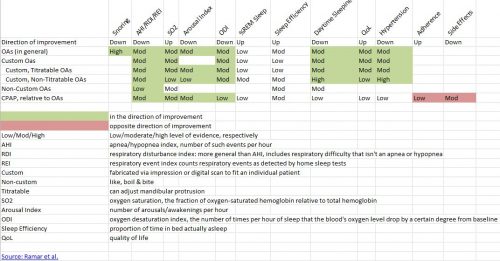Naturally, I have not read all the literature on the effectiveness of oral appliances (OAs) for snoring and sleep apnea among adults, nor will I ever. But this 2015 systematic review/meta analysis by the American Academy of Sleep Medicine and American Academy of Dental Sleep Medicine sets a high bar for organization. For that reason alone I’ll call it “the best.” But, maybe it’s not best by other standards. I really don’t know.
The only thing it lacks is a table to summarize the findings, so I made one. An image of it is below. The Excel spreadsheet is here.
I’m not going to define all the terms. They’re in the image (click to enlarge) or spreadsheet. But, if you know them and want to understand the chart’s cells, the words low/med/high mean level of evidence (higher is best); green means in the direction of improvement, red the opposite. (The only two red cells are for adherence and side effects, indicating that CPAP is worse in those categories, relative to OAs.) Cells with no color means no statistically significant finding. Cells with no values mean no studies reported.
Some takeaways:
- Oral appliances are effective in all the categories that CPAP is effective, but have the advantage of better adherence and fewer side effects. CPAP is more effective in addressing many symptoms of sleep apnea, but not statistically significantly better in many other categories.
- Custom OAs (those fabricated via an impression or digital scan) perform better than non-custom OAs, but there aren’t a lot of studies on non-custom OAs.
- Non-titratable OAs perform quite well, to my surprise. An advantage of them, a dentist who makes OAs told me, is that they’re less prone to breaking.
- OAs are effective for snoring, with a high level of evidence.
- I’m surprised at the %REM and sleep efficiency findings. Not consistent with my N=1, subjective experience. Cool.
- OAs can be effective in reducing hypertension.
The one big bummer is that, at least for studies that made the cut for this systematic review, we don’t know much about non-custom OAs. That sucks because they’re the least expensive way (among those in the chart) to try to address snoring, a super common and bothersome problem that isn’t covered by insurance. Few snorers would want to shell out the big bucks for a custom OA or CPAP. It’d be nice to know more about the cheaper options.
(Having said that, I am aware of at least one study of non-custom OAs for snoring. It’s too recent for this review. I’ll blog about it soon.)



